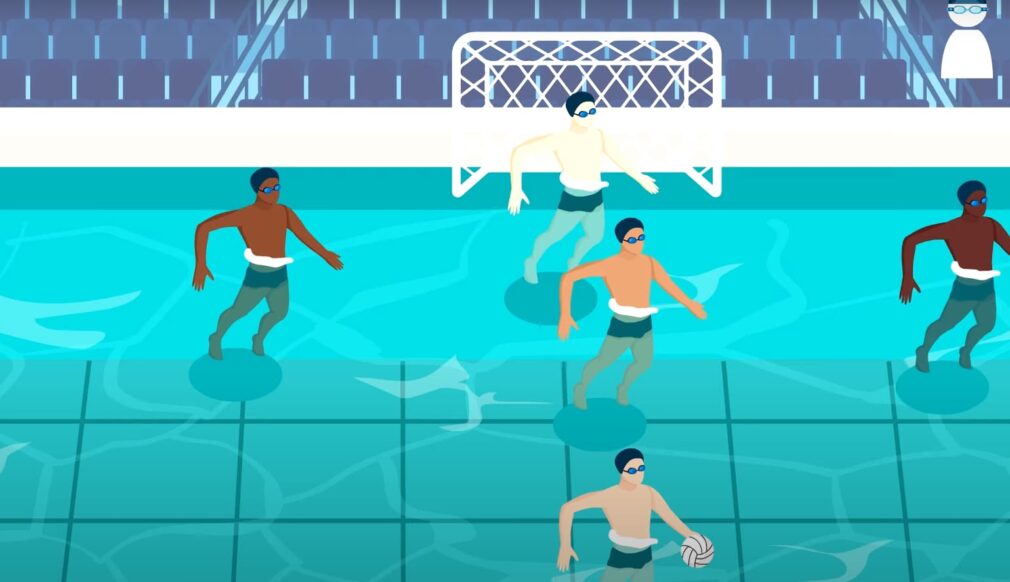Water polo is a contact-driven sport, and accidents are common. Because a coaching staff may pull their player from the game for fear of a possible concussion if one unintentional elbow or lunge to the face occurs, safety headgear is critical.
Water polo is a high-intensity sport that requires split-second decisions. Because the game is so fast-paced, water polo athletes must be able to think quickly and react accordingly. Wearing a helmet allows them to do just that. If you are in the market for the best motorcycle helmet speakers to enhance your riding experience, be sure to explore the available options.
In addition to protecting their heads, water polo helmets also help athletes stay focused and avoid distractions. The last thing an athlete wants is to be hit in the head with a ball while they’re trying to concentrate on the game. Wearing a helmet eliminates this possibility.
Water polo is a sport that many people may not be familiar with. It is a team sport that is played in a pool, and the objective is to score goals against the opposing team. One of the most important pieces of equipment for water polo players is helmets or caps. But why do they wear helmets? In this blog post, we will explore the reasons why water polo athletes wear helmets and what benefits they provide.
What Do Water Polo Helmets Look Like?
Water polo helmets are similar to those worn by other contact sports like football and hockey. They have a hard shell exterior with a faceguard to protect the wearer’s head and face from impact. The helmet should fit snugly and be comfortable to wear for extended periods.
Water polo safety caps are usually constructed of a thick material with hard, plastic shells on either side of the helmet to protect the ears in the event of a collision. A closer look reveals that the protective ear casings have small holes in them. This design prevents water from entering and makes it simpler for players to hear.
Most water polo helmets also have ear guards to protect the athlete’s hearing from the constant noise of the pool deck and crowd noise during games. Some helmets also have a chin strap to keep them secure on the head during play. If you’re looking for more information on outdoor gear or equipment, be sure to check out the OutdoorProfy website for a variety of helpful resources.
The helmet may be simply secured by tying the strings into a knotted bow beneath the chin of the player. Players wear a swimmer’s cap in addition to swimming gear to protect their hair from harm during competition. This gives the headgear a more stable fit and eliminates the risk of hair pulling.
While not every league requires a helmet, it is recommended for players of all levels. Water polo can be a dangerous sport, and the use of proper safety gear is essential to preventing injuries.

Reasons Why Water Polo Athletes Wear Helmets
To Prevent Ruptured Eardrums
Water polo is a contact sport. There is a lot of splashing and hitting going on in the pool. If an athlete were to take a hit to the head without any protection, they could easily rupture their eardrum. A helmet protects the ears from this type of injury.
Water polo helmets also prevent other ear injuries, such as concussions. A concussion is a type of brain injury that can occur when the head suffers a blow. Helmets help to absorb some of the impacts and protect the brain from concussions.
While water polo players are not immune to concussions, wearing a helmet does reduce the risk of sustaining one. This is why many coaches require their players to wear helmets during games and practices.
Some water polo leagues, such as NCAA, have even made it mandatory for all athletes to wear helmets. This helps to ensure that all athletes are protected from head injuries while playing the sport.
To Prevent Acute Injuries
Water polo is also a very fast-paced sport. The ball moves around quickly and players are constantly moving around the pool. This can make it easy for players to collide with each other accidentally. Wearing a helmet can help protect against these types of accidents as well.
Helmets also help protect against concussions. Concussions are always a risk in any contact sport, but they can be especially dangerous in water sports. This is because the water can cause the brain to swell more quickly than it would on land. Wearing a helmet can help reduce the risk of a concussion by absorbing some of the impacts from a hit to the head.
Water polo helmets also have a faceguard attached to them. This is to protect the athlete’s teeth from being knocked out or broken. A hit to the face can be very painful and cause serious damage. The faceguard will help to prevent this type of injury.
To Ease Strain on The Upper and Lower Body
Wearing a water polo helmet can also help ease the strain on the upper and lower body. The helmet helps to distribute the weight of the head more evenly. This can help reduce neck and shoulder pain. It can also help to prevent headaches. Wearing a helmet can also help to protect the spine from being injured.
Some water polo helmets also have padding on the inside. This can help to protect the head from being hit by the ball. It can also help to cushion any blows to the head that may occur during a game.
To Help Differentiate The Teams
Water polo is a team sport that is often played in close quarters. This can make it difficult for players and referees to keep track of who is on which team. Wearing helmets can help to differentiate the teams and make it easier for everyone involved to know who is on which side.
The color, number, and design of the caps are all different. Players on the visiting side will wear black caps, while those on the home team will wear white caps.
Goalies in NCAA matches and FINA international games wear numbered “1” quartered red caps. In NCAA games, substitute goalies have caps that read “1-A” or “13”.
Each team will wear two sets of caps: one white and the other black. The numbers on the cap must be different from the color of the cap, as well as the color of the ball, according to NFHS water polo uniform rules.
FAQ
Why do they wear a helmet in water polo?
Water polo is a contact sport played in a pool. The object of the game is to score goals by throwing the ball into the opponent’s net. Players can use any part of their body, except their hands and arms, to move the ball around the pool.
Because water polo is such a physical sport, players are required to wear a helmet to protect them from head injuries. In addition to helmets, players also wear mouth guards and ear guards to protect themselves from injuries.
While some people may think that wearing this entire protective gear makes water polo players look like they’re ready for battle, it’s just a necessary part of the game. Players need all this gear to stay safe so they can play the game they love.
What is the point of swim caps?
Swim caps are designed to keep your hair out of your face while you swim. They also help to keep your head warm in cold water and can protect your hair from the sun and chlorine.
Swim caps aren’t meant to keep your hair dry, but they do provide a little layer of protection against chlorine damage. In the colder months, it helps to keep my head warm by keeping the water in my head warm.
Hair minimizes clogging in our filters and protects our water supply and filtration system.
Water polo is a sport that is played in a pool. The game is similar to soccer, but instead of kicking the ball, players pass it around with their hands and try to score goals by throwing it into the other team’s net.
Players wear swim caps to keep their hair out of their eyes so they can see the ball better. They also wear them for protection against getting hit in the head with the ball.

Do water polo caps keep water out of ears?
Yes, water polo caps do keep water out of your ears. In addition to providing a comfortable fit, they also help to protect your ears from the harsh chemicals in pool water.
Water polo caps also help to keep your hair out of your face so that you can see clearly while you are swimming. If you have long hair, it is especially important to wear a cap so that your hair does not get in your way.
Finally, water polo caps can help to prevent injuries to the head and face. When you are playing water polo, there is a lot of physical contact between players. Wearing a helmet can help to protect you from being hit in the head by a ball or another player.
Why do swimmers wear 2 caps?
One common question we get asked is why swimmers wear two caps. The short answer is that it keeps the hair out of the way and provides a tight seal around the head to help keep water out.
While most people only think of one reason to wear a swimming cap, several benefits make them worth wearing, even if they aren’t the most stylish accessory.
In addition to keeping your hair out of your face, caps also:
- Help protect your hair from chlorine damage;
- Keep your head warm in cooler water temperatures;
- Reduce drag in the water, which can help you swim faster;
- Help you avoid getting sunburned on your scalp;
So, while they may not be the most fashionable item in your swim bag, caps can be worth wearing for the benefits they provide.







